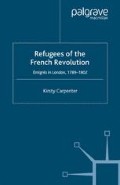Abstract
In contrast to Soho, the old parish of St Mary-le-Bone housed the elite of emigration.1 The early years, 1789–94, were characterised by conspicuous consumption; the latter ones, 1795–1802, by an elegant sufficiency. But throughout the period, the lifestyle of the émigrés who lived in these areas provided a stark contrast with the inhabitants of Soho, Somerstown and St George’s Fields. The politics were exclusively royalist or ultra-royalist and this was reinforced by the arrival in London of the comte d’Artois and the duc de Berry in 1799 and the Prince de Condé in 1802.
Access this chapter
Tax calculation will be finalised at checkout
Purchases are for personal use only
Preview
Unable to display preview. Download preview PDF.
Notes
Gordon Mackenzie, Marylebone, Great City North of Oxford Street, London 1972, p. 229.
Le Colonel de Guilhermy, Papiers d’un émigré, 1789–1829: Lettres et notes extraitées du portefeuille du baron de Guilhermy, Plon, Paris, 1886. pp. 116–17. Jean-François César de Guilhermy took refuge in Britain in 1801.
Mallet du Pan, Mémoires et correspondance, Paris, 1951, Vol. II, p. 369.
A. Bardoux, La duchesse de Duras, Paris, 1898, pp. 57–8.
Margery Weiner, The French Exiles, 1789–1815, London, 1960, p. 100.
Harting, Catholic London Missions from the Reformation to the Year 1850, London, 1903, pp. 231–3, cited by Wilkinson, op. cit., p. 484.
A. Grangier, A Genius of France: a Short Sketch of the Famous French Inventor, Sebastien Érard and the Firm He Founded in Paris 1780, translated by Jean Fougueville. (Third Edition, Paris, 1924);
Pierre Érard, The Harp, In its Present Improved State Compared with the Original Pedal Harp, London, 1821;
and F. Fétis, Notice biographique sur Sebastien Érard, Chevalier de la Légion d’Honneur, Paris, 1831.
A. G. L’Estrange, ed., The Life of Mary Russell Mitford, Authoress of our Village. Related in a Selection of her Letters to her Friends, London, 1870, Vol. 2, p. 102. Letter dated 5 July 1820, to Sir William Elford.
T.H.R., Cashmore, The Orleans Family in Twickenham, 1800–1932, Twickenham Local Historical Society, 1982.
Copyright information
© 1999 Kirsty Carpenter
About this chapter
Cite this chapter
Carpenter, K. (1999). Marylebone, Richmond, Hampstead — the High Life. In: Refugees of the French Revolution. Palgrave Macmillan, London. https://doi.org/10.1057/9780230501645_5
Download citation
DOI: https://doi.org/10.1057/9780230501645_5
Publisher Name: Palgrave Macmillan, London
Print ISBN: 978-1-349-40391-2
Online ISBN: 978-0-230-50164-5
eBook Packages: Palgrave History CollectionHistory (R0)

